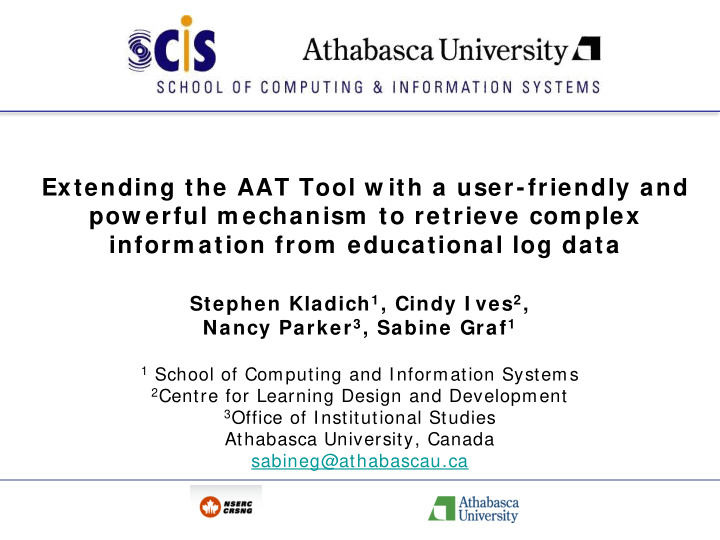



Extending the AAT Tool w ith a user-friendly and pow erful m echanism to retrieve com plex inform ation from educational log data Stephen Kladich 1 , Cindy I ves 2 , Nancy Parker 3 , Sabine Graf 1 1 School of Computing and Information Systems 2 Centre for Learning Design and Development 3 Office of Institutional Studies Athabasca University, Canada sabineg@athabascau.ca
Motivation In online education, educators and learning designers typically don’t get much feedback on whether or not their teaching strategies and course designs are successful/ helpful for students. Learning Management Systems (LMSs) generate a lot of data But learning designers and educators don’t have skills to use these data (e.g.: SQL) 2
General Aim of Research How to provide support for users without computer science background to access complex LMS data? Our research is based on Academic Analytics Tool (AAT), a browser-based application that can access and report on the data generated by any LMS 3
AAT Overview Aim is to allow users (e.g., learning designers, teachers) to extract detailed information about how students interact with and learn from online course in a learning system, to analyse the extracted data, and to store the results Allow users to decide and specify w hat data they are interested in (rather than choosing only from pre-defined information) Designed for analytics in educational institutions and therefore aims at flexibility with respect to the choice of course (rather than focussing only on one single course) Applicable for different learning system s and different versions of learning systems (not only one particular learning system) 4
Architecture of the Tool Five design elements Concepts Logical constructs of interest to the user (such as a course, discussion forum, quiz etc.). Patterns Based on concepts Specify what data the user is interested in (and what data should be extracted) Dataset Courses that the user is interested in 5
Architecture of the Tool Templates make the tool applicable for different learning system s specify w here the data resides within the database of the learning system (i.e., what tables and columns) templates can be created for different learning systems and different versions of learning systems and then used for extracting data from the respective (version of) learning system Profiles Experiment for extracting and analysing particular data User specifies: – W hich learning system is used (through templates) – How to connect to the data (through selecting and setting up database connections) – W hich courses/ learning objects should be investigated (through selecting the data set) – W hich patterns should be investigated Once the profile is created, it can be used for extracting data 6
User-friendly and powerful mechanism for pattern creation Focus on pattern creation Create a user-friendly but powerful mechanism to allow users without computer science background to extract and analyse complex educational log data This mechanism is based on Ontology to store knowledge of the tool Pattern Chaining to build on simple pattern for creating complex ones Pattern Creation Wizard user-friendly interface 7
AAT Ontology 8
Pattern Chaining Facilitates the creation of complex pattern through chaining simpler patterns together Two types Using one pattern as input of another ( restrict result set) Merging two patterns ( expand result set) Requires storage of additional data (e.g., identifiers of tables, etc.) and meta-data (e.g., from which location the respective data have been retrieved, etc.) 9
Pattern Creation Wizard 1. Create a patterns from scratch 2. Create a pattern by using en existing pattern as input 3. Create a patterns by chaining two existing patterns 4. Perform an analysis on an existing pattern 10
Pattern Creation Wizard Patterns are created via intuitive wizard interface Users select Concepts Users select Concept Attributes Users select Limits (filtering) Users save the Pattern Users run the Pattern 11
Pattern Creation Wizard An analysis (or calculation) on an existing pattern user selects the base pattern the type of analysis (i.e., counting, calculating the sum or average, and presenting the minimum or maximum) the concept attributes on which the respective analysis should be performed. Analyses can either be performed for one attribute, resulting in a single value (e.g., the number of forum postings in a course), or for one attribute per concept, resulting in an additional column of the result set of the base pattern (e.g., the average number of postings per student). 12
Conclusions and Future Work AAT is an innovative tool to allow users without computer science background to access and analyse LMS data We introduced a user-friendly and powerful mechanism for pattern creation, including an ontology, pattern chaining and a pattern creation wizard AAT facilitates course designers’ learning about the effectiveness of their course designs as well as educators’ learning about the effectiveness of their teaching strategies Future work: advanced visualization of data adding statistical functionality (e.g., regression, correlation) conduct an evaluation with learning designers and educators 13
Recommend
More recommend